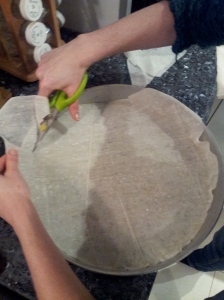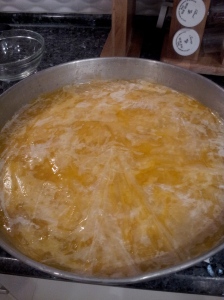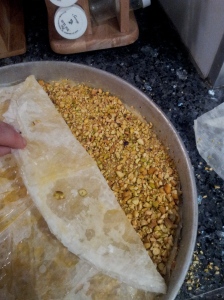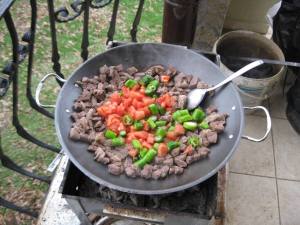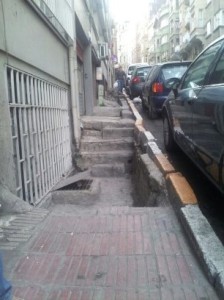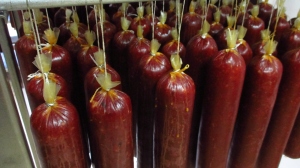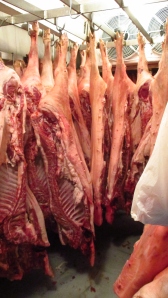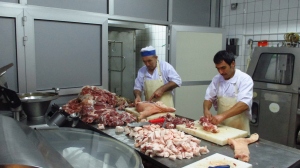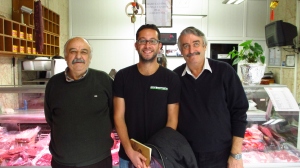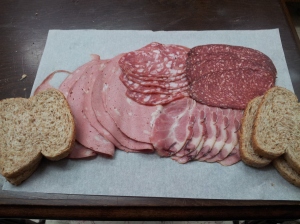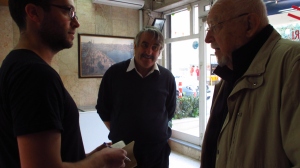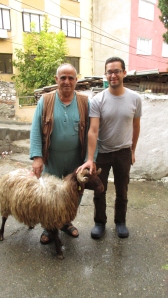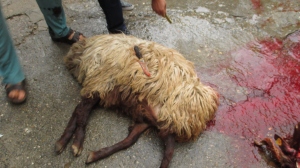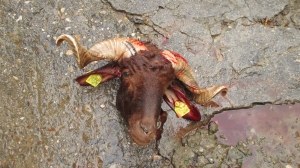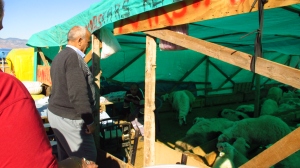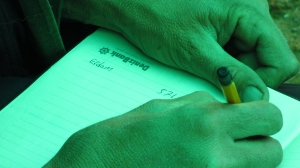I was lucky enough to talk about my research with Michael Mackenzie, on his show RN First Bite, from the Australian Broadcasting Corporation. Go give it a listen here.
Author Archives: edurgunoglu
World’s Best Baklava Recipe
From The Sultan’s Kitchen cookbook.
I’m always reluctant to proclaim something as the “best,” as it automatically invites disagreement. And who the hell am I to proclaim “world’s best baklava”? I sound like a real prick. But don’t take my word for it; here are actual reviews from Turks when they tasted this:
“Really good! Wow! How did you make this? Can you show me how to make this? We usually buy baklava for bayram, but I’m going to make this instead! When are you making this next? I need to watch you make this.” [Drools]
Thanks, Zeynep! How about another one?
“Whoa, awesome! This reminds me of when women make baklava and bring it to parties or households for informal local competitions!” [Eating noises]
Oh Yavuz, jeez, I’m blushing. Any others?
“Wow, super good. Hold on I need to eat some more.” [Creams jeans]
Stop it, Oğuzhan, you’re too kind!
“What Erdem has done with this baklava is nothing short of a sonic soundscape of flavor profiles harkening back to a pastoral crunchiness lost in the paradigm of modern, Chopped-Last-Chef-Standing tête-à-tête stovemanship. Our first bite made us say “Yeezus, that’s amazing!” The syrup felt twee, but in a way from which David Lynch would have sneeze-farted a movie treatment. 6.8”
Shut up, Pitchfork! How’d YOU get a piece???
What’s the secret? Simplicity. Most baklava recipes that have radiated outwards from Turkey incorporate oranges, cinnamon, honey, cardamom, etc. like they’re building a fucking Yankee Candle. What exactly, about the combination of sweet-flaky-buttered-sugary-nutty needs such drastic tweaking? It’s madness, I tells ya, MADNESS.
For any baklava recipe, you can improve it a million percent by using pistachios instead of walnuts. Walnuts, relative to ‘stachios are downright shitty. (That’s RELATIVE, mind you; I like walnuts in salads and in the Turkish dish Çerkez tavuğu [Circassian chicken], but other than that I give walnuts a great big passive sigh.)
Not to mention, pistachios are also more “classic” for baklava: the most renowned/famous/delicious/pick-your-adjectiviest baklava is said to come from Antep*, in southeastern Turkey, near the Syrian border. The Turkish word for pistachio is “Antep Fistiği” (Antep nut). I mean, the etymology pretty much DICTATES that you use pistachios.
Enough chit chat, here’s the recipe:
2.5 C cold water
3.5 C sugar
2 T lemon juice
3.5 C pistachios
2 T sugar
2 packages of yufka (phyllo dough), thawed. This is where it can get tricky. You don’t want the thick shitty yufka (*cough*ATHENS*cough) they sell in the frozen food aisle, which should only be used for börek/spanakopita. You need the light, thin, delicate yufka, like an angel’s labia. We went to a specific “yufkacı” (yufka shop) and bought these two packs of baklava yufkası. Each pack had 24-28 sheets that were about 24” x 24”.
If I were you, I’d check with Greek or Middle Eastern markets. If they don’t stock it, they’d definitely know where to get it.
Lots and lots of unsalted clarified butter**. I would start with about 2 Cups, but have some extra butter handy to make more if you need it. (If you have a package of dough with 28 sheets rather than 20, you’re going to use way more butter rather than waste the sheets.)To clarify butter, slowly heat the butter and skim the milk solids off the top. You can do this off heat once the butter has separated. Then pour the ghee into another pan, leaving a majority of milk solids on the bottom. It doesn’t have to be 100% clarified, so just do your best.
Preheat the oven to 375 F (190 C)
For the syrup, combine the cold water with the sugar in a saucepan. Boil the mixture for 5 minutes, lower the heat and simmer, uncovered, for about 15-30 minutes. The syrup is ready when the color slightly darkens, and it’s, well…syrupy. If it’s TOO thick and candy-like, you can always add a splash of water and adjust the viscosity.
Once your syrup is ready, stir in the lemon juice and let it cool.
OK, time for the nuts. You can do things the easy way, and buy shelled roasted pistachios. Or you can do the insanity method and buy unshelled nuts and shred your nails down to the quick. I recommend unshelled. Otherwise, it takes two people approximately three hours to shell 3.5 cups of pistachios.
Chop the nuts with a knife; don’t use a food processor. You can have different size pieces, but what you DON’T want is the whole batch to be powder. My method is to rough chop a few handfuls, drag my hand over the top of the pile, thus separating the larger pieces, and then chopping those big pieces. That way the smaller pieces stay out of the way. If you have a civil engineer dad, like I do, they’ll say this is just granular convection.
Separate ½ cup of the finest-chopped nuts, and give them another once-over to really pulverize them. Set them aside for sprinkling on top after the baklava is baked.
Toss and mix the chopped filling nuts with the 2 T of sugar.
The size of the pan you use doesn’t really matter. You’re going to do 20-25 layers on the bottom, then nuts, and then another 20-25 layers on top. I did mine in a giant circular pan. If you do it in a small rectangular baking pan, just cut your yufka to fit.
IMPORTANT TIP! To save time and potential yufka drying out, remove one sheet, place it over the pan you use, cut a template, and then lay it back on the stack of sheets. Cut the rest of the sheets to fit the template. No more messing around and fussing with buttered layers. BUT, don’t start working on the yufka until you have completely finished your prep.
Are your nuts are all chopped? Your butter clarified and lukewarm? Do you have a silicone brush resting in the butter and ready for use? Has your oven been preheating for at least 30 minutes? Have you scratched your genitals thoroughly? If yes, then go ahead and open the yufka. It’s a race against time, so you have to work quickly. If you’re using multiple packages, only open them one at a time.
Brush the inside of your pan with some clarified butter. Place one sheet of yufka in the pan. Brush the layer completely with butter in a thin layer. Working quickly, repeat the layering-brushing for 20-25 layers.
Spread the nuts over the dough and lightly sprinkle them with water – I just flicked a couple splashes of water with my fingers. This helps the dough adhere to the nuts where the next layer is added – you’re not drenching the nuts, just spritzing them.
Make another dough template with the second package (if you’re using two). Layer the dough over the nuts, brushing each sheet with clarified butter, as before. Brush the top layer and the edges with butter.
Using a sharp knife dipped in hot water, cut through the dough HALFWAY down the height of the pan to make as many pieces as you’d like. (It’s important to cut halfway down, because the top layers are going to puff up, while the bottom layers will stay flat and later soak up syrup). Baklava is usually cut to a rhombus/diamond shape around 1.5 – 2 inches a side.
Bake in the middle of the oven for 30 minutes. Lower the heat to 325 F (162 C) and bake for an additional 30 minutes, until the top is lightly golden. Remove the baklava from the oven and let it sit at room temperature for 15 minutes. Recut the baklava along the lines, all the way to the bottom of the baking pan. Be careful here to not lift up and slide the delicate flaky layers on top. If they pop off just move them back.
Pour the cooled (but not cold) syrup evenly over the cut lines; you might not have to use all of it. Start with about 2/3, and see how much is soaking up in the bottom. What you’re looking for is the bottom layers to soak up the syrup, while the top is lighter and crunchy. Contrast!
Sprinkle the baklava with the finely chopped pistachios and let it cool completely. Call your friend with a nut allergy and laugh and laugh.
If you have a lot of dough trimmings, grab a really small baking pan and make a mini-baklava. Follow all the steps as above and bake it after your main baklava has come out. (Make sure to preheat your oven again!)
*It’s officially called “Gaziantep”, which means “Veteran Antep,” but people in Turkey still call it Antep without batting an eye. It got the name Gaziantep after the city fended off zee French in 1921 during the Turkish War of Independence.
**I’ve heard scary, scary stories of people in the Aegean region mixing their butter with olive oil for baklava. I pray that this is merely a tale, meant to scare children. Otherwise, that’s a crime against food on par with margarine.
Eating Pork in Turkey
Yes, you CAN buy pork in Turkey. It’s not easy, convenient, nor socially-accepted, so you kind of have to buy it and shame-eat, like what I do with Totino’s Party Pizza.
To get your hands on pork, however, you have to be in the most Westernized parts of Turkey, like İstanbul, İzmir, and down the Aegean-Mediterranean coast. Some of the Fulbright English Teaching Assistants, stationed in the deep-reaches of Anatolia, far from easy access to life staples such as pork and booze, visited İzmir for the first time a few weeks ago and were smitten. They took to calling it “Jizz-mir,” which I really should have thought of twenty years ago.
Important note: there is a way to get pork through non-commercial channels. Lots of people hunt wild boar in Turkey, and if you get an in with some hunters, they’d gladly sell or gift you the carcass. If you need help breaking the boar, gimme a call!
The southwestern towns in Turkey (Çeşme, Marmaris, Fethiye, Antalya, Bodrum, e.g.) have enough English, German, Spanish and Russian tourists to sustain pork availability at restaurants and a few grocery stores. The Migros stores in İzmir have a small and sad selection of pork products, just above the eggs.
My family comes from İzmir , which has a long history of being a melting pot. Actually, I don’t think I’ve ever seen a Turkish household kitchen with a “melting pot.” Let’s call it a “saç tavası” of cultures. From what I’ve gathered, my own heritage is Greek, Balkan, Jewish, i.e. Aegean-Mediterranean, BUT NO GYPSY THANK GOD (just kidding, please don’t steal my wallet).
It’s interesting how centuries of immigration, warfare, assimilation, and admixture are summed up as food analogies: “America is a mixing bowl,” my grade school teachers would declare, reflecting the tail-end of early 20th Century philosophy on new Americans assimilating (read: “acting more like a now-accepted white ethnic group”), abandoning their parents’ language, and learning about weird white person shit like advent calendars, James Spader, and cotillion balls.
Soon after, in school we were taught to emphasize multiculturalism. The mixing bowl was put back in the pantry. My parents wrote impassioned letters to Yankee Ridge Elementary School on behalf of all the immigrant families that DIDN’T celebrate the birth of Jeebus. Time to teach “America is a fruit salad!” We’re a mixture that celebrates our individual components! Hooray!
The analogy is a noble one, save for the fact that fruit salad is gross. You end up eating only the bananas and the kiwi, while ignoring the tannin-bomb grapes, which inevitably roll off your church-basement-quality paper plate. The cantaloupes are always rock hard, the strawberries white and tart. Paella! Now there’s a multicultural food analogy I can get behind, Lena Dunham’s idiocy about the dish be damned!
I don’t hang out much in elementary schools as much anymore (THANKS A LOT, MEGAN’S LAW), so I can only guess that what they’re teaching is some sort of “America is a farm-to-table, neo-liberal/pro-business, domestic partnership!”
So basically, Duck Dynasty, but without all the backwoods buttfucking.
People are often pejoratively described as a product of what they eat. Beaners, Fish-heads, aaaaaaaand I should stop listing racial slurs. Not adhering to a perceived cultural norm leads to more food analogies: coconuts and Oreo cookies, for example, used for minorities engaging in “white” behavior.
You can see such judgmental food forces at play in Turkey. The idea of pollution stemming from pork, a taboo meat in Islam, has potentially influenced (I would argue) Muslim Turkish views on Turkish ethnic minorities. I have to be cautious of discussing pork butchery with every Tom, Dick, and Harry Turgay, Deniz, and Hakan, because I’ve seen people physically recoil and shudder (no, REALLY, they FLINCH!) at the thought of touching and eating a pig.
THE LAST PORK BUTCHER SHOP IN TURKEY
Mary and I were in İstanbul to shepherd our three friends around the major must-see sites (Aya Sofya, Blue Mosque, Grand Bazaar, the Cistern, İstiklal Caddesi) and after they left I had one solid day to do some research. I had been meaning to visit the last remaining pork butcher shop in Turkey, located a mere 15 minute walk from our AirBNB flat. Hearing about the shop was like hearing reports of a unicorn. People thought I was lying when I spoke of the Kozmaoğlu brothers’ butcher shop.
Once you get off İstiklal and head north two blocks, tourists and boutique stores disappear. We strolled through narrow winding streets, tire shops, and over a dusty overpass. The butcher shop is not on a main street; it’s tucked across a Petrol Ofisi gas station, with only a red-lettered “Ideal Salam Kozmaoğlu ” indicating you’ve come to the right place.
We walked in and I recognized the two Kozmaoğlu brothers, Kozma and Lazari, from the website. Lazari, the older brother, and founder of the shop, was short, bald, and had a moustache that made him look like an Asterix and Obelix character. Kozma had mid-length gray hair, a similar moustache, and a lazy eye. They both looked…Greek. I noticed that their jaws, eye orbit shapes, and noses differed greatly from the general craniofacial characteristics of older Muslim Turkish males.
The guys were sitting and chatting in the back while two women were standing and working in the front. Classic Turkish style! The older woman was slicing charcuterie into neat overlapping piles; while the younger one was vacuum-sealing the meat stacks. I’m going to conservatively estimate that the vacuum sealer put out a decibel equivalent to a harrier jet raping a banshee in an echo chamber.
Cold call ethnography always feels like you’re approaching a lady at a bar; you’re trying to come across as nice, trustworthy, interested, and not creepy. Mary has observed a lot of my Turkish interview transactions (the ethnography part, not the approaching women in a bar part), and cogently observed that flattery is the key. Come out and say you’re a fan, or you love some aspect of what the person approached is doing, and it softens the cold interaction. My problem is, I LOVE what the Kozmaoğlu brothers are doing, but the way I show that interest comes out as “ZOMG TELL ME EVERYTHING ABOUT WHAT YOU DO EAT MEAT REPEAT NOM NOM NOM NOM!!!!!” Needless to say, I usually get a look usually reserved for golden retrievers humping pants.
I gave the brothers my spiel: researcher, food, meat, anthro, US-born Turk. The shop was really quiet, and then punctuated with disorienting noise of the vacuum sealer. I was standing in front talking to a tough crowd for what seemed like hours. My hair started to itch and I desperately needed to remove my jacket. I felt like I was bombing on stage.
I went right into some specific questions: Where was the meat from? Any flak from Erdoğan-supporting beardos and their head-squeezer wives? I got half-squinted eyes and monosyllabic responses. I blathered on a bit more. They asked specifically where I was from, which in Turkey means “where is your family from?” Aka: “I need to make sure you’re not a religious weirdo who intends to fuck with my business.”
“Uh, my family’s from İzmir , but I’m a dual citizen who is here to do some res– “
“İZMIR !” exclaimed Kozma. “The land of foreigners, infidels and people who drink booze!” He smiled and nodded knowingly at Lazari.
“Yes’m.”
“But you don’t SOUND Turkish; you sound like a JEW!” (Funny, Mel Gibson said the same thing to me once!)
“Ummm, thanks? I’m actually American, but you know…Turkish as well?” Oh Christ, was I really practicing Turkish uptalk?
“PFFFFFF, Lazari, lookit this guy, he’s an AMERICAN! Lemme show you around!”
I had the room! They rose from their chairs and approached the counter. The women, who I later learned were Kozma’s wife and daughter, stopped their pretense of fake-working in order to eavesdrop and openly listened.
The identification rigmarole is a necessary part of owning a shop dedicated to selling a meat perceived as filthy and sinful by the majority population, as well as prevention against sketchy journalists looking to rile up the masses. There never was much freedom of the press in Turkey to begin with, and lately there have been mass firings and “ideological adjustments” (euphemism alert!) at prominent newspapers. It’s quite common for a CHP-supporting left-wing Turk to lament the “fall” of a certain newspaper after Erdogan’s AKP had an editor sacked and replaced with a sycophant. I’ve also been hearing a lot about “kaçak et” (illegal/smuggled meat) in Turkey, which is often horse or pig meat being driven in from Europe and sold to hotels and restaurants. (Meat is quite expensive in Turkey). Understandably, this has caused a huge public outcry, and for the meat industry in Turkey, any press tends to be bad press.
Kozma took us on a very quick tour of the huge shop. We barely had time to snap pictures of the three floors, a huge walk-in, a massive sucuk-curing room, and a locker room with laundry and shower facilities. Whole-animal butchery has a strong visual component in the United States; people want to watch a butcher break down an animal because it symbolizes openness and a gesture that all questions and observations are on the table (literally). There’s a performance and a transparency that the American Slow Food consumer demands, because the industrial American food system deals in monoculture, suffering, and corporate welfare. (Food festivals will often celebrate the visual component of butchery, where teams compete to see who can break down an animal the fastest and make the nicest looking assemblage. I don’t really give a fuck about speed butchery, but it’s still amazing to watch Martin Yan break down a chicken in 14 seconds, or Oscar Yedra bone out an entire chuck in 30 seconds.)
At the Kozmaoğlu shop, the breaking all happened out of sight, in the basement, by two unsmiling guys. I asked what they did with the neatly-separated bones and the fat. Kozma said they threw it all away, save for some fat and skin that went into the charcuterie. It’s not that the brothers are blind to the value-added potential of roasting bones for stock, or rendering fat for lard, but there’s absolutely no market for it. Another hurdle: since none of the Muslim employees are willing to taste the charcuterie, Kozma has to make all of it. His product is fantastic, but it doesn’t give him much time off from work. (For his wedding and his mother’s funeral, Kozma went to work right after).
After the tour Kozma invited us to sit down behind the counter. The brothers are Christian Turks, from an ethnic minority in Turkey known as Rumeli. Lazari, the older brother, answered the phone at one point and took an order in fluent Greek. I feel a little overwhelmed at the diversity I encounter on a daily basis in Turkey. My own Turkishness feels diluted, as though even if I were born and raised in Turkey, I’d still have a hard time understanding the cultural day-to-day of Anatolia. Much of that, of course, is that secular Turkey INTENTIONALLY distanced itself from the religious whackjobs*, so I never had any experience from my family.
As a rule, unfortunately, life is harder for ethnic minorities. The brothers didn’t disguise their resentment towards societal prejudice of their profession. I asked where their family was from, and they said İstanbul, by way of Nevşehir. (Nevşehir province is home to world-famous Kapadokya). Kozma said he was tired of people asking where they were “really” from, since he points out that his family has been in Anatolia longer than most. “When people ask me where I’m from,” he said, “I usually just say ‘my mom’s pussy.’”
TOTALLY stealing that, btw.
The brothers lamented the loss of Christian butcher shops in İstanbul. There used to be eight shops in İstanbul alone that sold pork. One by one, they closed; some from family mismanagement, but most from the structural societal pressure that emphasized pork as sinful. Whole animal butchery is a disappearing trade worldwide, but pork butchery in Turkey faces an extra level of negative selective pressure: there are no trade schools teaching pork butchery, so all this: the store, the ethnic minority expression of valuable food culture; seems destined to disappear when the brothers retire.
I mentioned that I would be traveling east for my meat research, to cities such as Gaziantep and Urfa, and Kozma got irritated:
“Fuck that! Why would you want to go east?! They kill sheep in shit and dirt and then eat it.”
I didn’t feel like mentioning that I had done exactly that a few weeks ago, for the Feast of the Sacrifice. As with most prejudices, they don’t run in one direction.
We chatted for an hour more or so. I was hungry and my brain fried from information overload. I made the mistake of saying we needed to leave to get something to eat.
“You’re hungry? Why didn’t you SAY so?” Kozma asked his wife to slice us mortadella, sopressata, and pretty much anything in the case. He grabbed some bread and put a jar of spicy mustard in front of us.
Lazari chimed in: “Imagine having a tall beer or a glass of rakı with all that!”
Well yes, obviously, that would be delicious.
We ate like kings. Their charcuterie was so well done I felt bad that no one in Turkey was giving them the respect they deserved.
Customers filtered in and bought their smoked pork shoulder, their speck, and their bacon. Men in chef’s coats came in to pick up restaurant orders. Once we finished eating, we bought several pounds of bacon**, and some of what we had just eaten. We said our goodbyes, and promised to be back.
If you’re in İstanbul, make a trip to the shop! Tell that pork-starved Italian lady you’ve been scamming on to follow you to a fun secret location***. Buy some charcuterie, two bottles of wine (which they also sell), and go have a picnic in Gezi Park. There, I just did all the legwork to get you laid awkwardly in your hostel while four strangers are forced to listen.
Make sure to call first, especially on the weekends, as they sometimes close early without notice. Click on the “Ulaşım” tab for a map to the shop.
*Redundant
**The bacon was great, since we haven’t had any in so long, but it was more like salt pork, as Kozma doesn’t use any sugar in his bacon cure. It was sliced a little thin, so it cooked up similar to what Commonwealth countries would call “rashers.” Made for a fantastic BLT, though!
***Don’t make it sound rapey, obviously.
Thanks always to Mary H. Brown for the photographs! Go look at her blog right now! http://blotsee.wordpress.com/
Çılbır: Poached Egg in Yogurt with Spicy Frothed Butter.
I’m surprised that I had never eaten çılbır until well into my twenties. It’s the ultimate whip-something-up snack in a Turkish household. It is seconded by sucuklu yumurta, which is just sunny side up eggs with spicy sausage slices. (Sucuklu yumurta = pork-free bacon and eggs, if you will.)
Ottoman sultans are said to have eaten çılbır as far back as the 15th Century, because after a long day of orphaning future Janissaries and screwing harem girls, you need to maintain your protein intake!
Some people have strong opinions about poached/runny eggs and any yogurt that isn’t specially bioengineered to make you poop, so çılbır is a good litmus test for weeding out dickhead eaters.
It’s easy-peasy: chuck some yogurt in a bowl, like a couple cups’ worth. Make sure it’s fatty, fresh, thick and tangy, like Oprah with a yeast infection.
Poach 1-2 eggs. I like poaching my eggs (two and a half minutes, at a steady simmer) in salty water with a splash of vinegar. Place your egg(s) on the yogurt, taking care not to break them. The cold yogurt should stop the eggs from cooking. Salt and pepper the eggs and yogurt generously.
Go pick some mint from outside. Really wash it off, as there are cats EVERYWHERE here that love mint and peeing on things you value. Turkish mint varieties have small leaves so I don’t bother with a dice/chiffonade, but if you’re using something American like Kentucky spearmint, chop it up.
What makes çılbır so ball-drainingly awesome is the addition of the paprika-cayenne frothy butter that goes on top. It’s the same butter you see on İskender döner kebap. Heat your generous pat baby-fistful of butter over medium-low heat until it gets melty and slightly frothy.
Don’t wait too long, as you don’t want smoking hot butter that burns the spices. The addition of a fat pinch of paprika, a bit of cayenne, will give the butter the desired foam effect. Give the pan a quick shake and drizzle over the eggs and yogurt. If you feel like you’re putting too much butter in, call me and I’ll come to your house and smack you in the mouth. DUMP ALL OF THE BUTTER.
You can add Aleppo pepper (pul biber – the ubiquitous red pepper condiment at each Turkish restaurant table) to the butter, but I like putting it directly on the eggs and yogurt. Looks cooler.
Top with mint. If you don’t have fresh mint, dried is OK. I like eating mine with a spoon and a half loaf of bread to mop up all the goodness. Make sure to break up the egg and swirl it around the yogurt.
Ingredients – Adjust the proportions as you want; I’m not the boss of you.
Eggs
Yogurt (My favorite yogurt type in Türkiye is “kaymaklı,” which means the yogurt has its fatty cream-top.)
Butter
Paprika
Cayenne
Aleppo pepper
Mint
Salt & Pepper
Splash of vinegar or lemon juice
PSST!!! HERE’S A SECRET TIP THAT FEELS LIKE CULINARY CHEATING:
You can put spicy frothed butter on anything. A piece of toast, some lentil soup, a hobo’s penis, ANYTHING. Try it!
Thanks as always to Mary H. Brown for the photo. Find her at http://blotsee.wordpress.com/
Perfect Izmir Day
Wake up groggy, because apparently Efes Pilsen puts bear hibernation strength formaldehyde in their beer. A big day of bank errands, shopping, and döner-eating await!
Time to hit the ground runn–
First clear the table of the forty dishes that comprise a Turkish breakfast. Everyone likes chores! Make sure to put away the bread basket, sucuk plate, the cucumbers, the tomatoes, the feta cheese, the sugar cubes, the salt, the pepper, the soft boiled egg holders, the olive oil, the tea glasses, the tea glass coaster plates, the black olives, the green olives, the oregano, the Aleppo pepper, the tiny salt shakers, and the cutlery. It’s like an archaeological assemblage. Yes, sometimes Slow Food can be a pain in the ass.
Understand the appeal of a quick bowl of cereal now, even if a splash of milk turns my intestines into a chemical weapons factory.
Glance out to see what people out and about are wearing. Sweaters and hats and gloves? Must be freezing!
Weather is 28 degrees Celsius and sunny. Immediately begin flooding underpants with sweat. Swamp ass in Turkish is “bataklık götü.” Not a saying, but I’m determined to have it become one.
Say hello to our ever-growing army of street cats. Have a previously-sweet but now aggressive cloudy-eyed male mount my leg. Dread the prospect of taking him to get fixed. Pull up pant leg to examine the pinpoint blood drops on my leg. Stupid horny cat.
Catch what you think is a dolmuş, but what in fact is a local city minivan that looks like the Mystery Machine. Avoid asking any questions as you careen away from the cardinal direction of your original intent. Smile/grimace and say “it’s part of the adventure!”
(Protip: a dolmuş is basically a white taxi. The dolmuş of days past were the minivan things we got on. More important protip: if there’s a wrong turn, vehicle, or physical gesture to be taken or done, I will somehow always find my way to it).
Get told to sit down in a seat the INSTANT one is vacant. Say “hey, it’s cool, I’m OK standing,” and have ten people yell at you at how unsafe you’re being.
Stand up to offer seat as soon as a woman gets on.
Am now standing.
Someone gets off, I am immediately directed to their seat.
Repeat this game of musical chairs for thirty minutes while trying to figure out where we are.
Get off at Karşıyaka Metro station when every single person gets off. We’re somewhat close to where we want to be, but the random turns, rapid acceleration, and circular route have you feeling like a hostage recently removed from a trunk. Apparently we took a tour of the Şemikler neighborhood.
Walk wrong way for 45 minutes. Keep following “Feribot” signs that appear to have been rotated by those evil goblins in “Labyrinth”.
Finally find main street in Karşıyaka that you’ve been looking for. Begin search for famous döner restaurant, Sakıpağa.
Walk obliviously past said restaurant multiple times by mere feet because the logo has a very distracting ayran-being-poured graphic, and because I am an idiot. Give up on food for the time being, as it is now 30 degrees Celsius and I need someplace with air conditioning right away before I have to wring out my underwear.
(Sure, it’s sexy when a WOMAN says “wring out my underwear,” but when a GUY says it, how come it’s considered “UN sanction-violating mental torture” and “sexual harassment?”)
Go shopping with lady, because she needs clothes. Get yelled at in store for daring to take clothes between levels OF THE SAME STORE, which apparently operate with a floor-as-Teutonic-fiefdom concept of retail management.
Six transactions for five items later, step out ravenously hungry.
Take a random hollering preteen restaurant busker’s recommendation and pop into a restaurant for a döner sandwich.
Ask for four ayrans for two people. “You want four?” Evet, dört lutfen.” DÖRT ayran? Again, yes, goddammit.
Feel like a fatty.
Go to Garanti Bank to get debit card from new Turkish account. Room is 8,000 degrees. Understand why no one moves even in the slightest to help me. Welcome back to the swamp, dick and balls!
Get informed that the card has arrived, but they lost it.
You LOST it?
“Well, the courier lost it.”
How?
“We gave it back to them since we didn’t know what it was, and they lost it.”
Sounds like YOU guys lost it, maybe?
“…”
Return to bank two weeks later, after Bayram, and find that card has been there the whole time. Card was in envelope with language on the front that effectively said “This is a new card for a new bank account, so here it is, keep it safe, KTHNXBAI.”
Waddle past aforementioned famous döner restaurant, not hungry in the least. I MUST HAVE THIS DÖNER.
Man at ordering counter looks like Estelle Getty. Get cut off in line multiple times because of silly concepts like “personal space” and “waiting my turn.” Get Jumbo döner sandwich. Ask for four ayrans.
“Did you say FOUR?” (Sad trombone).
Fill sandwich to the brim with spicy pickled peppers. Make appointment with toilet later. (It will be worth it).
Go home in time to watch Galatasaray blow a three-goal lead against marginal Anatolian squad.
Begin drinking Efes.
Killing an Animal
We picked up Zeynep, her husband, and their son from the Turan Metro station, just past the Karşıyaka bridge, where the road turns sharply eastward towards Alsancak and the other side of the İzmir Bay.
Zeynep’s mom and dad live in Gültepe, which is east of Konak. (We previously met Turgut Bey at the hayvan pazarı) It’s before the Çevre Yolu (the perimeter freeway). The Çevre Yolu is almost exactly like I-580 in Oakland, but a more remote version. Gültepe means Rose Summit, but it was pretty much all Tepe and no Gül. A rainy night in a rental car with five people navigating steep hills is a stressful way to enter into an animal sacrifice situation.
We drove up, up, up Gültepe until we came to a street dead-ended by a staircase. The rain was steady at this time, and there were thunder rumblings.
The house was filled with aunts, uncles, and kids. One of the kids fetched a rock to place under my car tire, as the hill was dangerously steep.
Mary and I met everyone, put on our guest slippers, got our customary handful of limon kolonya, and went into the living room to drink tea and eat baklava. After 30 minutes of chit chat, it was time to initiate sacrifice sequence! Turgut Bey went into a small bedroom to pray, and then we went outside.
The sheep looked the same since I had seen him last week. He wasn’t panicked or twitchy, just calm and slightly stubborn in the way that sheep are. I started to tell him “hey buddy, it’s gonna be okay,” but cripes, he was walking the Green Mile.
My sheep had been living here for two days, in a tool shed with its own drain. Turgut Bey made sure to point out the drainage, lest I think that they were allowing the blood to run into the street.
Turgut Bey put on his butchery outfit; green pajamas with a leather vest. Looks like he stole my Halloween costume idea: Muslim Power Ranger.
Turgut Bey picked up the sheep and gently placed it on its side. Then he tied three of the legs together. Everyone gathered around to watch. I felt clumsy as I tried to hold my notebook and my camera while trying to help hold the sheep down. It was kind of like when you’re trying to give an animal a pill; you need to find that sweet spot of firm, yet compassionate force. Any excess wrangling or roughing up would be considered an “eziyet” (mistreatment) to the kurban, and my thought process was along the lines of “don’tfuckthisupdon’tfuckthisupdon’tfuckthisup.”
I had not participated in the namaz (prayer) before the sacrifice, nor was I planning on participating in the two prayers required after the sacrifice, so Turgut Bey was to kill the sheep. Since it was my purchase, the sheep was technically mine to kill. I had to formally give my vekalet (agency/representation) over to Turgut Bey so that he could perform the sacrifice. He asked me three times for my vekalet, same question each time, and then it was time to cut. The repetition reestablished the emphasis on agency transfer, and made me feel like some execution-happy Texas governor.
The knife, albeit a bit dull, had been blessed, so we couldn’t use the razor-sharp 7” boning knife I had brought along. (Helal butchery dictates the blade must be sharp, but the defintion of “sharp” is, like most religious decrees, subjective). The blade was inscribed with “Bismillah ir-rahman ir-rahim” in Arabic, meaning “The name of Allah, most gracious, most compassionate.”
Turgut Bey took the knife and placed it flat-side against the sheep’s throat. The sheep looked on plainly, definitely a bit uncomfortable, but used to being handled by people. Then the knife was dragged back and forth as if shaving the sheep’s neck, in order to smooth out the wool and locate the cut site. I was holding the sheep down tightly with Zeynep’s son and brother. Turgut Bey said “Bismillah!” and sliced the sheep. It took a few hard, directed cuts to get through the jugular and carotid, and Turgut Bey was sprayed by a meter-high blood spurt. The sheep didn’t have time to bleat, but there was a gurgling croak just as I saw the occipital condyles appear. I saw the spinal arteries, which was when Turgut Bey briefly paused to mention that those were the “can damarlari” (life veins). Technically speaking he’d cut the life veins, but as soon as the vertebral arteries were cut, the animal was, how to put it, “more dead.”
Everyone observing was calm, but not nervous or bummed out. This is a festive holiday, after all, but tinged with the solemn fact of death, of transforming a life into meat. Once the head was removed, the knife was carefully placed on top of the still-convulsing sheep’s body. The head stared at me calmly, and I saw the masseter muscles flex and relax. The knife on the sheep is meant to absorb the rest of the animal’s life. The knife is an artifact of negative-energy absorption, mirroring the ubiquitous blue evil-eye in Turkish culture.
Turgut Bey told Zeynep to put some blood on my forehead.
Turgut Bey untied the sheep’s feet, and cut into one of the rear shanks. Using a metal rod he bored a subcutaneous hole from the shank to the pelvis. He blew into the hole to loosen the skin from the muscle and gave the body a few gentle pats to disperse the air.
Skinning was a group project, with Zeynep doing most of it. Ahmet Bey, the neighbor next door and a leather tanner by trade, popped over and finished the job. He took the hide home with him after helping butcher some of the cuts.

The blood in the cavity was steaming as Ahmet and Turgut Bey explained how to remove the gall bladder from the liver.

Zeynep with the eye, which she planned to dry and keep as a souvenir. She still has her henna markings, applied on the first day of Bayram.

Opening up the stomach, aka tripe, or “işkembe.” The smell was too strong for Mary to stand this close. Turgut Bey did this to show me how well the sheep had eaten prior to sacrifice.
The meat was portioned and we retreated inside from the rain. Zeynep and her niece sat on the kitchen floor boning out the sheep legs and cubing the meat. This was for the traditional post-kurban kavurma. Kavurmak as a verb means to cook/roast/sauté. It is related to the Urdu korma. In the Indian food sense, it’s a braised meat dish, but the traditional Turkish kavurma after the sacrifice is pan-cooked meat, medium-high heat, seasoned with salt. I wanted to sit in the kitchen and take notes of the preparation, but the men beckoned us to sit with them and drink tea. The family also made me take off my ever-so-slightly damp shirt and put on a new one. It’s a little awkward to go into a room with two teenage boys whom you haven’t had a chance to meet, say hello, yank off your shirt, and expose them to one’s chest pelt. Did I say “awkward?” I meant INCREDIBLY awkward.
Zeynep’s brother and her sisters apologized for the fact that we were going to eat on the floor of the living room, as is customary in most of Turkey, and I tried to coherently explain that we also sat on the floor at home, especially during Game of Thrones night.
The spread was great; a communal plate of kavurma, bowls of yogurt-mint soup with sheep brain, salad, homemade pepper/garlic/tomato pickle relish, and bread. They didn’t cut bread with a knife, as it was günah (a sin). A tall beer would have been the best thing ever, but it was not to be, obviously. Turgut Bey had slaughtered a cow for their whole family the day before, and we got to try some beef kavurma as well.
We ate ourselves silly and the family graciously fielded all of my questions. My favorite part of the process was the neighborhood interaction. While we were outside butchering, families would walk by and wish us “İyi Bayramlar!” while kids would look on, not scared or grossed out. Is this the way my hypothesized “meat consciousness” begins manifesting itself in Turkish people? In the US we shield kids from scenes of animals dying, lumping a respectful ritual sacrifice in with stories of pre-psychopathic kids torturing cats or disgruntled housewives boiling bunnies. Even the term “butcher” is linguistically loaded; as if someone comfortable with slaughtering and breaking down animals could make the leap to humans, like a cultural form of the flu virus.
THE BUTCHERY & DISTRIBUTION
There was no Butcher Boy band saw, obviously, but I had expected to at least see a handsaw. In this environment you see how the lack of artifacts such as electricity and machine-standardization influence not only meat processing, but recipes and diets. Rough cuts of a small animal like a sheep (my guy yielded about 15-20 kg of meat) mean lots of bones and fat, which mean lots of low-heat braising dishes. This in turn influences fuel sources, pot and pan shapes and materials, and time appropriation for food preparation. Compare it to the American steak/hamburger culture, with mechanically-aided clean cuts of meat and high-energy grills and stoves. Americans (and this is a broad generalization that intentionally ignores American braising culture!) tend to like high-heat, quick cooking in general, and our meat choices/options reflect that.
If I’m cutting up a lamb like we did at The Local Butcher Shop in Berkeley, we begin the same way each time: by splitting the animal in half on a transverse, at the skinniest point of the waist. Then we plop each section on the band saw and sagitally cut it into two halves, so you end up with four sections, a limb on each one. This is more or less standard; barring any specific customer requests, we can in theory prep every lamb like this. (Shank removal is optional, and usually removed to fill out a nice braising platter, but meat keeps longer/resists oxidation in its whole form, this the benefit of cutting to order). Shoulder chops, rib chops, and loin chops are all cut on the band saw to desired thickness. If you’re feeling rustic, you can pre-cut the rib and loin chops with a big knife, and then use a cleaver-rubber mallet combo to break through the vertebral bones.
The purchaser of the kurban (that’s me!) gets to keep 1/3 of the animal. I had my mind set on the short loin; I’d get lamb loin chops! Without a saw, however, it was impossible to get the clean cuts needed for loin chops. I felt a bit crestfallen at ending up with rough cleaver cuts of loin sections with bone shards aplenty. I’m thinking of making a quick-braise, but I’m open to suggestions.
As I just mentioned, the bayram dictates that one third of the meat goes to the purchaser/purchaser’s family, one third to the extended family, and one third to the less fortunate. You are supposed to have enough meat to distribute to seven families. According to Zeynep’s family, you want to at least give one kilogram of meat to a needy family.
I asked how a less-fortunate family was designated or made known, and Zeynep’s brother explained that in a tightly-knit community, that was easily known.
We drank our coffee, offered profuse thanks, and headed home.
Buying an Animal to Sacrifice
Touchy-Feely-Anthro-Sensitive Disclaimer:
I must continuously acknowledge my social privilege as a Turkish male; I can more or less insinuate myself into the realm of meat and religious ritual without causing any offense within an increasingly religious populace. This is an important affirmation when dealing with the cultural sensitivity and messiness of animal sacrifice (I sound like I’m writing up a concert rider for a GWAR show). Having said that, let’s go buy an animal!
Going to the Pazar
The İzmir Hayvan Pazarı (Animal Market) opens a month before Kurban Bayramı (The Feast of the Sacrifice), staying open every day until Bayram eve (Arife günü). The days right before Bayram, much like the shopping environment in a Walmart before Christmas, are an unholy mess of gas-guzzling trucks navigating around overweight, glassy-eyed grazers.
One of the best ways to understand what a kurban (sacrifice) could be is to discuss what it can’t be. The animal selected cannot be sickly, old, or too young. It can’t have any broken horns, cloudy eyes, or a limp. The ears must be large enough (this is a somewhat subjective metric). The bottom four teeth (mandibular medial and lateral incisors) have to be present and robust. The sacrifice must be just that, a sacrifice to your assets. The goal is to give your best animal to Allah, not some sick fleabag.
Zeynep, a family acquaintance, has been going to the pazar her entire life. She’s İzmir born-and-raised, but her entire family hails from Kars, deep in Anatolia on the Armenian border, meaning they’re legit country-folk accustomed to buying, killing, and cooking their own animals. Zeynep’s dad, Turgut Bey, was to be our pazar guide, negotiator, and victim to my pestering questions.
We went to Yeşildere, meaning “green stream,” in the shadow of a giant bust of Atatürk carved into a mountain. From where we’re staying in Mavişehir/Karşıyaka, it was a 30 minute drive, looping east and then south around the bay of İzmir, on the same road you take to get to the airport.
The pazar is in the city. Like IN THE MIDDLE of the 3rd largest city in Turkey. The Bay Area equivalent would be if the Laney College Flea Market in Oakland had only animals instead of stolen bikes.
The weather was bright, brisk, and windy; some real Anatolian steppe weather. As soon as we got out of the car we smelled what cheese enthusiasts refer to as “barnyard notes,” but what most other people refer to as “animal feces.” While waiting for Zeynep’s dad to arrive, we endured the kind of salesmanship and bargaining reminiscent of the Istanbul Grand Bazaar crossed with the last helicopter out of Saigon. I felt like a pretty lady at a bar; the vendors were really nice, offering to bring us tea and trying to get us to feel the back fat on their sheep. Their cigarette ashes were impressively long.
Zeynep called her dad back for the fourth time. Turns out he had taken the exit by the southernmost mosque. An understandable misunderstanding, as there’s been a real Starbucksification of mosque building in Erdoğan’s Turkey.
Zeynep’s dad brought a troop of relatives who giggled at our English and tried to decipher what I was writing in my notebook.
Turgut Bey is something of a local celebrity at the pazar; groups of people would stop him every few steps and ask what and where he planned on purchasing his animal. He would chuckle and offer a noncommittal answer. It takes a while to get used to the open staring (dik dik bakmak) in Turkey, and we definitely were an object of curiosity. My notebook scribbling, pointing, and questioning initially had some of the vendors suspicious that we were government inspectors. The shiksa goddess (Mary) taking lots of pictures had a few people asking if we were from a TV show.
Each enclosure had the vendor’s child watching over the animals. As far as I could tell, the kids were mainly in charge of pushing the sheep around, wrenching their horns, and grabbing any escapees. Occasionally they would break up ram-fights and the overly horny ovine, like little cockblocking prison guards.
Everything is negotiable, of course, but sheep started at about 400 TL and went up to about 700 TL. ($200 – $350 US). Cows are more variable. The calf that adorably tried to trample Zeynep was 1,500 TL, the cow that Turgut Bey bought for their family was 2,700 TL, and some of the larger steers (950 kilograms and above) were going for 5,500 TL. The Lira-Dollar conversion is super easy; just divide the Lira amount by two.
After we had seen the whole Pazar, Turgut Bey directed us to a reliable vendor for my sheep purchase. I had my eye on a handsome little number with a brown head and pleasant horn curvature. The vendor said it was 575 TL, but Turgut Bey turned to me in an aside and said “Sure, he says 575, but we won’t be paying that.” We felt the lower back (short loin) to gauge meatiness. We ignored the sheep I wanted for a while, and focused on the marginal animals. Then it was time for the haggle dance!
Turgut Bey told the vendor I was but a mere student, I didn’t have much money, and that the sheep were small and overpriced. This was countered with protestations of minimal profit made per animal and the paltry number of pairs of pants that the vendor could afford (The number of pants was three, which is more pairs than I have). Handshakes would be proffered, held onto tightly, and then wrenched away as the “final” price was changed before the final, deal-sealing handshake pump. In the end I paid 525 TL for a nice animal. Tag number 571266.
The goats we saw could not be used for a kurban, but they could be used for an adak offering. (More on adak later, it’s super interesting, I swears!).
When someone has bought an animal, it’s good form to say “Hayırlı olsun, Allah Kabul etsin!” (Good luck, I hope Allah accepts your sacrifice!) . My sheep would be transported to Turgut Bey’s house together with the cow he purchased for his family. (I was initially a little stressed that I would have to transport my sheep in a rental car, thus DEFINITELY having to pay the shitting-in-the-car-fee those greedy car rental places are always making me pay). The sacrifice was scheduled for Tuesday, the first day of Bayram.
Our purchase made and social rounds completed, we sat in a mosque courtyard and drank tea with a plate of chicken wings. As we walked out of the pazar a little after 4, the afternoon call to prayer began.
The Raw and the Cooked
This article in Vice, later picked up by the Daily Mail, is about a guy named Derek Nance (two first names!) in Kentucky who only eats raw meat.
By analyzing the tone of the authors’ presentation, we can infer some general culinary taboos and notions of acceptable Slow Food behavior. When faced with the fact that an animal must be purchased, killed, carved up, and then refrigerated, the authors revert to a distressing discourse of taboo, pollution, and ostracization. I would also argue that more specifically, the authors are distancing themselves from a person that would deign to assert control of a very ancient and basic nutritional practice. Big Ag and the industrial food system require conformity for commodification, so anyone stepping out of the grid is generally subject to the language of weirdness and elitism.
First, the picture. It’s a brilliant piece of imagery; feeding the disgust felt by people when confronted with the pervasive blood-taboo of food. It’s like watching a pride of lions lazily noshing on a zebra during a generic animal program. Blood smeared all over their muzzles, flies buzzing around, some haughty British voice narrating. Even Ace Ventura 2: When Nature Calls gets a solid laugh out of that very image, so you know I’m bringing the hard social science, SON.
I understand Vice’s (and the Daily Mail’s) effort to push page views, but Derek’s teeth could not possibly ALWAYS be red (unless he had a habit of chewing betel nuts); the Vice author, Julian Morgan, who is also the photographer, obviously took this picture as he was eating something dripping with blood, like a liver, or maybe a spleen. (Essentially, an “off” cut, something the majority of meat eaters would have never even come across nor have considered eating.) My studies of teeth in osteology and forensic anthropology bias me toward the streetlight effect, but the [Vice] author puts Derek’s bloody rictus before any text appears. Teeth are not only a valuable postmortem bioarchaeological analytical medium; they are an indicator of dietary patterns, nutritional surfeit/scarcity, a crucial step in digestion*, and most pertinently for our discussion: an indicator of social standing.
I used to be extremely self-conscious of my Michael Strahan tooth gap. It didn’t match the uninterrupted grills of my orthodontia-blessed classmates. Personal hang-ups aside, I was keenly aware that perfect, straight teeth were societally desired. Now, I don’t really give a shit about how my teeth look, but I will say that when I drink red wine, I look like a jack-o-lantern. Good or bad, we judge teeth, as they are immediate indicators of health and social standing. Historically, gap-toothed women were thought of as super-horny pole smokers. Let’s see, you’ve got Chaucer’s Wife of Bath, Madonna, and Condoleeza Rice, so, check, check, and che-MADAM SECRETARY I HAD NO IDEA!!!
American stereotyping of bad British teeth is as pervasive (and as clichéd) as saying all British food is bad. Recovering meth addicts have a hard time adjusting to a world without Breaking Bad a society equating teeth with health and reliability. Bloody teeth, as seen above, connote savagery; a fell divergence from a civilized society that would prefer we didn’t chomp bloody meat, let alone do it with our mouths open. The chosen photograph opens with a salvo of the raw-meat-as-savagery narrative.
In a nutshell, the article discusses Derek being unable to eat anything without losing weight and getting sick. After trying everything from gluten-free to vegan, he discovered a raw meat diet, and subsequently bought, slaughtered, and stored his own animals. As the author puts it:
“For reasons I don’t properly understand I wanted to watch Derek eat a meal and he obliged.”
Ooooohhhh shit, sarcasm BURN, y’all! You know, just in case you guys thought the AUTHOR was some raw meat eating freak show, guys! I don’t think it’s malicious intent on the author’s side, per se, but the weirdo-distancing from the subject matter is evident. Doing one’s job as a journalist could also be “a reason” when “reporting” “stories.”
Derek’s methods, in his own words:
“I’m into lamb mainly. It’s just easy to go out to farms, barter over a decent price, slaughter it and throw it in the truck. It’s a lot harder to deal with beef because it’s a lot bigger. Pigs are kind of a no-no because they shoot them full of hormones and raise them on grains, which promote bacterial growth.”
Hmmm, sounds pretty awesome. Sounds like the epitome of Slow Food and off-the-grid independence. He’s even discerning in his meat choices, as well as completely knowledgeable about the product! The interviewer asks if Derek is “comfortable personally slaughtering animals,” and the response:
“Well if an animal lives in accordance with its nature, I have no problem ethically slaughtering that animal. But if you raise that animal in a pen and when it’s sick just shoot it up with antibiotics, I have real problems with that. It’s not just unfair on the animal; it’s unfair on the people who eat it.”
The industrial food bias is evident in the author’s question. God forbid someone be “personally” comfortable with animal slaughtering! That’s a job for a faceless factory worker, or a farmer! (Note: the existence of small, sustainable, locally-focused family farms is only a rumor at this point, like a unicorn, or a reasonable Republican.) My master’s thesis was about this very idea of cognitive dissonance in industrial meat eating. Perhaps if you’re not comfortable with someone “personally” slaughtering an animal, then you yourself shouldn’t be eating meat?
Derek then shows off his meat fridge, which the author refers to as his “Jeffrey Dahmer fridge.” ROFLMAO WILL THE SARCASTIC BON MOTS EVER STOP?!! Granted, no one likes a stuffy egghead pointing out how this or that is offensive and culturally relativistic, and there’s the real potential of the Dahmer crack being an offhand joke, but I bristle at equating raw meat storage (and consumption) with cannibalism. Would the author make the same crack about a plate of carpaccio, a tower of tartare, or a sushi spread?
The Daily Mail version is more or less similar to the original copy, with a few differences. The author, Sadie Whitelocks (more like WhiteCOCKS! See? I can make little asides, too!) refers to Derek’s “bizarre food addiction.” With a hat tip to Lévi-Strauss, that which makes the food “bizarre” and in the realm of inedible is not the duality of raw/cooked; it’s because the raw food in question is meat rather than plant matter. Raw food diets are currently quite popular, but I doubt Derek would be welcome to one of their potlucks.
My issues with the authors’ attitudes stem from the fact that Derek Nance is practicing Slow Food, but not in the cool way of boutique butcher shops and urban sustainable eco-charcuterie-with-an-Italio-Franco-Japanese-fusion-flair. He’s a guy in Kentucky hacking up lambs and eating them raw like he’s some Odyssey-reading villain on an episode of Justified. It would be more fruitful to use Derek’s dietary practice as an example of how Slow Food is not just the realm of the elite, but if that were the reality I wouldn’t be writing this.
Derek is seizing control over his health (as was initially intended) and over his local foodshed. Too much of the hand-wringing and finger-pointing about the state of fatties in the US addresses the symptoms, not the causes of the obesity crisis. It’s painfully simple advice to get off the couch, move around, grow a garden, and cook, but that doesn’t move pharmaceuticals or diet programs. (This doesn’t take into account certain urban settings that – because of extant discriminatory social systems – cannot easily grow or access healthy options). Derek’s actions should be celebrated; he’s not only butchering his own meat, which is very de rigueur, but he’s living with a vegan girlfriend, meaning he’s not some judgmental meat-chauvinist. Plus, on his YouTube channel he constantly comments on how George Michael is a musical god and Britney is overrated compared to Rihanna. So awesome.
How is it considered odd when someone eats nose-to-tail, whereas it’s normal to eat an ammonia-drenched and tortured beef patty from 100 different cows? I love that this example shows the vast and paradoxical richness to food studies: in one breath meat is a cultural artifact representing humanity, while in another it becomes equated with beastly barbarity.
*I don’t want to say “the first step in digestion,” because with the advent of tool usage and controlled fire, primates were able to “externalize” their teeth and their digestive organs. Knives saved our teeth from doing all the chewing, and fire made meat (and biomass) easier to digest. If you demand even more toothsome cultural anthropology, you could also make a case for the DECISION to start the fire, to hunt, to create a social system of feeding, all being important steps in digestion. Taking it a step further, all of this technology, from knives to blenders, has made teeth somewhat optional. We could eat blended food all day! What a world!
For a good read, check out:
Wrangham, Richard. 2009. Catching Fire: How Cooking Made Us Human. New York: Basic Books.
The Cranberries
My family grew up with an Aegean Turkish kitchen culture. “Ege Mutfağı,” if you will. This involves copious amounts of vegetables, beans, rice, and fruit. And then some more fruit, chased with fruit. Fruit after breakfast, after lunch, as an afternoon snack, then right after dinner, before dessert (unless fruit is the dessert) and just before coffee/tea service. It’s easy to be a vegetarian (or a frugivore spider monkey) in Western Turkey. Everything grows here, much like the Central Valley of California. Dishes like Zeytinyağlı Barbunya (Cranberry Beans stewed in olive oil) are relatively unknown outside of the Aegean region, and that makes me have sad-face. A majority of the Turkish culinary culture that has been exported and consumed by foreigners is kebap-centric, unfairly bolstering a stereotype of unhealthy drunk food. (It’d be as if my opinion of Mexican food was gleaned from eating post-bar-close burritos). The rich seasonal produce is bolstered by ubiquitous farmer’s markets, street corner grocery stores, and even donkey-pulled bahçevan carts that call out their wares. “Bahçevan! Karpuuuuuuz, kavuuuuuun, şeftaaaali!”
The organic market is still in its nascent stages in Turkey, but the emphasis on locality and the human element are present everywhere. I’ve seen customers in Turkey scold their manav (greengrocer) for selling them a dud watermelon. If you got a sour peach, some mustachioed-man was going to hear about it. Sure, these purveyors use pesticides, but their farms are small and their product is way better than the grocery store. Not to mention you can get a kilo of peaches for something absurd like 4 TL (about 2 bucks). I’m too scared to scold the North Berkeley farmer’s market vendors, since they’re surly assholes. (Great produce, though, guys!) Michael Pollan shops at the same market; I should ask him if he gets the churlish vibe. HOLD ON LET ME JUST PICK UP THIS NAME THAT I JUST DROPPED.
It’s an interesting perspective on the praxis of Slow Food: in California, I was always interested in how my food products were raised. Are they organic? Heirloom? Did the cows get to watch DirecTV and sip amontillado dry rich sherry after their evening graze? By eating like a food asshole, I’m consciously acting in a way that authenticates my food choices and sets my actions apart from the other – the industrial system. When it’s written like that, of course it seems elite and holy-shit-this-guy-thinks-his-shit-don’t-stink-ish, but I can easily argue that the industrial food system is broken. I can also argue that organic/local/insert trendy adjective tastes better. Hell, I can even make the argument that big agro’s latest GMO monstrosity can barely be called “food.”
In the same vein, although I don’t have a neat bookend for how Turks generally practice their Slow Food, my initial impression has been a focus on provenance as an indicator of quality, as well as a love of eating at home. Kids are often tasked to shell beans, the stove is usually working, and there are always dishes to wash.
Generally, I’m recipe-averse. I turn sysdelxic dyslexic in the face of a recipe. I hate reading fractions, steps, and the chore of having to read the whole thing multiple times to ensure success. I’d rather apply a few fundamental cooking practices while worrying about the salt/fat/acid/heat. If you fuck it up, who cares – tomorrow it’ll be shit; literally. Having said that, this is a dish worth making; it’s really flexible, you don’t need exact amounts, and the variation I’ve encountered from different cooks is staggering. I’ve seen it with almost no liquid – like a bean salad, without any parsley, with carrots, and so on. I like to make mine rather soupy, because the olive oily bean broth is ideal for swabbing your plate clean with some crusty bread. Serve cold, preferably the next day, with a large glass of ayran, and you’ve got yourself a complete meal.
Shamelessly taken from:
Algar, Ayla. 1999[1991]. Classical Turkish Cooking: Traditional Turkish Food for the American Kitchen. New York: HarperCollins.
2 pounds fresh cranberry beans in pods. Or buy a 1 pound dried bag of beans. I’ve made this with pintos, good mother stallards, and rio zape beans, since I can’t always find cranberry beans. They all work great. If you use dried beans, use Rancho Gordo.
1.5 cups finely chopped onions
½ to 1 Cup olive oil. (Use some good, green, grassy stuff, as this dish is one of the cornerstones of Turkish olive oil-stewed dishes).
1 Large tomato, chopped. I’ve noticed that Turks peel all of their tomatoes, and I’ve gleaned that it’s a combination of taste preference and getting rid of pesticide residues. I like the way the tomato skins curl up like wood shavings in a dish, so I never peel ‘em, pesticides be damned. I’ll probably be sterile in a month.)
2-3 long green peppers. Nothing too crazy spicy; 1 fat jalapeno also does the trick. If using skinny peppers, seed and chop into rings. If a jalapeno, give it a fine dice.
2 chopped handfuls of parsley.
Salt
Sugar
Lemon
Shell the beans. If using dried, soak them for a couple hours. Or don’t; it really doesn’t matter. I’ve made this dish with no soaking and with the oh-balls-I’ve-had-beans-soaking-for-three-days method. Just adjust your cooking time!
Cook the onions in the olive oil until softy and translucent. Medium to medium low heat. It should look like you’re cooking the onions in too much oil, but keep in mind you’re adding water and beans later.
Chuck in the chopped tomato and cook it until broken down and soft. (The tomato, not your penis).
Stir in the beans, peppers, a healthy pinch or five of salt, a pinch of sugar, and 2-3 cups of water. Cover and simmer until the beans are soft, but not mushy. Could be thirty minutes, could be an hour and a half. If you’re unsure of cooking time, check after 20 minutes and go from there. Make sure there’s enough liquid to cover the beans. If the water is too much for your taste, simmer with the lid open for a spell.*
Tamar Adler has forgotten more about beans than I will ever know, and I recommend her method for tasting at least five beans for doneness before you’re sure.
Toss in one handful of parsley and let it cook for a few minutes. If your beans are done or near-done, squeeze in at least one lemon’s worth of juice. Adjust your salt and acid at the same time. Keep in mind that you’re going to sprinkle a bit more lemon from the garnish, as well as adjust the seasoning once it’s cooled.
Sprinkle the remaining fresh parsley on top after the beans have cooled. Drizzle with olive oil, and serve with lemon slices, bread, and tangy yogurt.
*Important time saving note! Pressure cookers seem to have been invented for the sole purpose of bean cooking. You can skip all of the “to soak or not to soak” discussion if you prep the recipe exactly as above, and “simmer” the dish in a pressure cooker for about 8-12 minutes. Proceed with the lemon and parsley as above.
King Ding-a-Ling
Early September is the end of summer, and around İzmir, everyone clears out of Çeşme and goes back to school/work in the city. It’s also high-time for circumcisions (sünnet), as no boy between ages 3-11 wants to be the only kid in his school still rocking the hood!
In the last few weeks I’ve seen five weiner-snipping processions pass by, which involve a convoy of honking cars with people hanging outside of the windows like a Saudi Arabian drifting video. The little man of honor with the freshly cut little man is usually dressed in an outfit like this:
The little penis prince waves to everyone, and for the life of me, I could never seem to snap a picture in time. I didn’t want to sit and wait like a pee-parazzi, either, so just take my word for it. Circumcisions are increasingly common in hospitals, but the celebration and party remain. Group circumcision parties are also common, with families inviting almost everyone they know to the celebration. I bet the Evite template looks like this:
COME CELEBRATE ERDEM’S TRADITION TO MANHOOD! LET’S HOPE HE DOESN’T “LOSE HIS HEAD” IN THE EXCITEMENT! STARTS PROMPTLY AT NOON FRIDAY. WHAT ARE YOU WAITING FOR? CHOP CHOP!
– Bismill-lop that skin off; I’m there!
– Sorry, gotta cut ‘n run
– I’ve got a bris later, but I might make it.
I think this picture has more of an “official” look, so I’d definitely include it in Evite:
In fact, I have the dubious honor of remembering when I was circumcised. Being the eldest and the first Durgunoğlu to be born in the U.S., my parents wanted to give me the traditional trial by knife. For all they knew, they’d be moving back to Turkey after they wrapped up their grad school, so why not be as traditional as possible?
SMASH CUT to me at five years old. I came to in a cold hospital room in Urbana, Illinois. There was another naked person, a grown man, laying supine ten feet away. Had I woken up in the pedophile Matrix? My penis hurt super badly, like I had just slept with Lindsay Lohan. I wish I were making this up.
But at least I didn’t ever have to wear this little number:





